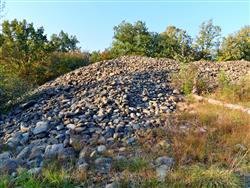|
Zubiena (Biella)- The Bessa
|
|
|
Show to visit in the Biella area: |
 The Bessa, the complete name of which is Special Nature Reserve of the Bessa, was established in 1985. It extends for about 7.5km2 and includes an elongated territory (ca. 7km x just over 1km) belonging to the municipalities of Borriana, Cerrione, Mongrando and Zubiena. The Bessa, the complete name of which is Special Nature Reserve of the Bessa, was established in 1985. It extends for about 7.5km2 and includes an elongated territory (ca. 7km x just over 1km) belonging to the municipalities of Borriana, Cerrione, Mongrando and Zubiena.
The Bessa is located in the Elvo valley at an altitude ranging between 270 and 430 meters above sea level. Its territory is located on the Biella side of the Serra moraine hill (among the largest in Europe) generated in the Quaternary by the large Balteo glacier coming from Val d'Aosta. It coincides with a low plateau of approximately ellipsoidal shape oriented from north-west to south-east and located between the Elvo torrent and the Olobbia torrent.
Many of the characteristics of the Bessa territory derive from the fact that the area was exploited as a gold mine for about a century between the second half of the second century BC and the first half of the first century BC.
However, it should be underlined that the area as it appears today is not the same as it was when the mines were closed, because in the following centuries agriculture and pastoralism were still practiced there (ARCHAEOLOGICAL EMERGENCIES, TRUE AND ALLEGED, IN THE AURIFODINES OF THE BESSA).
The first historical references to the area date back to Strabo and Pliny the Elder. Once the gold ran out, the area was almost forgotten until the eighteenth century, and it was only in the second half of the twentieth century that it returned to the spotlight and became objects of archaeological studies.
The entire area of the reserve is strewn with piles of stones, up to ten meters high. The piles are made up of nothing other than the waste material from digging for gold.
Between one pile and another, the ditches used to separate the gold from the finer waste material, which were originally covered with wood and inside which water flowed, are often still recognizable today.
Various roads are visible on the mounds, still with signs of the passage of carts or large sleds, probably used for the construction of the mounds themselves.
The remains of the perimeter walls of huts which probably housed those who worked in the mine are still recognisable.
The glacial origins of the area mean that numerous different types of rocks are present in it.
In particular, there are numerous erratic boulders (an example in Fig. 3). Some boulders are then characterized by the presence of engravings from the protohistoric era of still obscure meaning.
From the point of view of the flora, the Bessa park is influenced by the presence of numerous stone piles, equivalent, from an ecological point of view, to new environments to be colonised. Lichens and mosses, ferns, heathers and other shrubs are therefore very common. Among the tree species, oaks predominate. There are also wild cherry, birch, ash, black locust, chestnut and hazel.
Spring is the most suitable season to visit the park, because it allows you to enjoy the blossoming of cherry trees, cyclamen, dog roses and St. John's lily. The luckiest will also be able to admire the rarer Pulsatilla montana.
The fauna includes among the reptiles the viper, the rat snake and the Aesculapian snake, among the birds there is a significant presence of tawny owls and barn owls while among the mammals there are numerous species of rodents, the hare and the fox.
The beautiful season is then enlivened by a large number of butterflies due to the limited presence of human activities.
The Bessa park is crossed by various main paths and a larger number of secondary paths, some of which are not even shown on the map. None present dangers, but it is best to stick to the ones marked so as not to get lost.
The address indicated at the bottom of the page corresponds to the Visitor Center, where it is possible to park and where it is possible to collect information material, starting with the map.
Categories: Places of historical value of naturalistic value of landscape value
Via dei Monti, 73, 13888 Vermogno BI |
The Bessa: Further pictures in the section Photography |